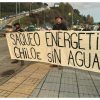Saturday, May 4, 2024
News and Views from the Global South
MEXICO: Little Oversight of Radiation Sources
Emilio Godoy
- In spite of the potential risks posed by unwanted or uncontrolled radioactive materials, Mexico lacks comprehensive mechanisms to keep track of these “orphan” sources, originally used in medicine or industry, and to prevent them going astray.
One example of the problem is a sealed unit of Cobalt-60, a substance dangerous to the environment and to human health, inside a Picker 3000 radiotherapy machine, that is no longer in use and was found in the northern town of Ciudad Juárez, on the U.S. border, IPS learned.
The material was located and removed as part of a programme for recovering lost or obsolete orphan sources, implemented by the Vienna-based International Atomic Energy Agency (IAEA).
The IAEA contracted a U.S. company, Neutron Products Inc., to collect orphan source materials originating from countries in Latin America and disassemble them in the United States.
“When these sources are registered, the authorities can exert appropriately strict control,” Benjamín Ruíz, of the Faculty of Chemistry at the National Autonomous University of Mexico (UNAM), told IPS. “The problem is that many of them enter the country illegally.
“If a hospital needs a tomography machine and wants to avoid the costs of importing it, they get one through contraband,” he said.
The National Commission on Nuclear Safety and Safeguards (CNSNS), which comes under the energy ministry, is responsible for supervising all activities related to radioactive materials.
CNSNS’s Radiation Safety Office has issued at least 1,897 permits in recent years for the possession of this kind of material. But the Cobalt-60 source described above does not appear in its records, and no technical expert is responsible for managing it.
“Large sources are well controlled,” Juan Eibenschutz, the head of CNSNS, told IPS. “In the 10 years I have been in this post, there may have been three or four very small sources that were lost and never recovered.”
The problem with those materials that get under the government’s radar is that they end up in junkyards, and are eventually acquired as scrap by the metallurgical industry.
That was, in fact, what caused the worst radiation accident in Mexican history in the mid-1980s. In 1977, a radiotherapy machine containing Cobalt-60 was smuggled into the country from the United States, at the behest of the private Medical Specialties Hospital in Ciudad Juárez.
In 1983, the machine was sold by two hospital employees to the Yonke Fénix junkyard, which sent it to the now defunct state-owned Aceros de Chihuahua, a steelyard, where it was processed into iron reinforcing rods and other metal parts that were distributed to 16 of Mexico’s 32 states. The authorities reported in 1985 finding 17,636 buildings containing radioactive reinforcing rods.
In another case, Tubos de Acero de México (TAMSA), the country’s main manufacturer of steel pipes, inadvertently melted Caesium-137 in a smelter in the southeastern state of Veracruz, and was unable to trace the source of the potentially lethal radioactive material.
“Industry has unfinished business in terms of disposal of sealed radioactive sources, plans for closing facilities down and the transport of radioactive materials,” Edmundo de Alba, an adviser to the National Ecology Institute and a member of the Intergovernmental Panel on Climate Change (IPCC), told IPS.
In February, CNSNS inspected 37 facilities handling radioactive material, less than its stated target of 55 visits. It also dealt with a radiation emergency, but has not given any details about the event.
At least 7,733 people work with radiation sources in Mexico, according to CNSNS, which has investigated 42 cases of exposure to abnormally high doses of radiation in the past few years.
Since 1999, the U.S. Off-Site Source Recovery Project (OSRP), managed by the Los Álamos National Laboratory, has identified and collected 24,029 open radioactive sources in the United States, 479 in Peru, 431 in Chile, 127 in Brazil, 36 in Ecuador, 19 in Argentina and two in Uruguay, but none in Mexico.
Since 1984, sizeable accidents involving radiation have taken place in Mexico, El Salvador, Costa Rica, Peru, Bolivia, Chile and Brazil.
Neutron Products Inc. did not reply to IPS’ efforts to contact it, and the IAEA said all its experts are presently focused on the nuclear accident at the Fukushima plant in Japan, following the Mar. 11 earthquake and tsunami.
According to UNAM’s Ruiz, the way to prevent losses and leaks of radioactive material is for CNSNS to “make a proper inspection of all the hospitals, and find out what services they offer, which of them involve machines with radioactive sources, and require hospital administrators to show how they were bought, when, and what their safety management plans are.
“The difficulty in identifying sources is that there is no existing record of all of them,” the expert said.
In 2010, the IAEA database on illicit traffic in radioactive materials worldwide was notified of at least 222 incidents, including unauthorised possession, attempts to sell or contraband these materials, and theft or loss of sources.
“Some incidents have occurred that have compelled an increase in international information and control of sources,” Eibenschutz said.
In December 2010, the Mexican government signed a Country Programme Framework with the IAEA, setting out technical cooperation between the state and the agency for the period 2011-2015.
The priority areas are nuclear energy and disposal of radioactive waste, radiation and nuclear safety, as well as human health, food security, water management and protection of the environment.

 Print
Print



